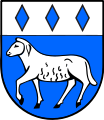Schwendi (noble family)

The von Schwendi family was an old Swabian noble family (see also list of Swabian noble families ).
history
The family's ancestral seat is Schwendi , today a municipality with the Schwendi castle rest in the Biberach district in Upper Swabia in Baden-Württemberg . At the time of the first documentary mention of the family in 1128, Schwendi belonged to Upper Austria .
Because of their possessions, the family belonged to the knightly canton of Danube . Burkheim , also known as Schwendi Castle, was one of the possessions .
In 1523, members of the von Schwendi family took part in the Franconian War in the wake of the Swabian Confederation (see also Wandereisen woodcuts from 1523 ).
Cathedral dean Marquard von Schwendi founded the pilgrimage to the Passau pilgrimage church Mariahilf in 1622 .
The line died out in the male line in 1689/1700.
The possessions of Lazarus von Schwendi
The most important representative is Lazarus von Schwendi (1522–1583). He was a diplomat , statesman and imperial general in the service of Emperors Charles V and Maximilian II.
In 1560 he received the pledge of the castle, town and rule of Burkheim am Kaiserstuhl with Oberrotweil, Oberbergen, Vogtsburg (today all town of Vogtsburg in the Kaiserstuhl ) and Jechtingen , and before that he had obtained the castle bailiff over Breisach . He built Burkheim Castle on the site of a ruined castle, today the only ruin of a Renaissance castle in southern Baden. The castle was destroyed by French troops in 1673.
In 1563 Schwendi bought the Alsatian estate of Hohlandsberg from the heirs of the Counts of Lupfen . In 1568 he was made baron of Landsberg by Emperor Maximilian II; the title was changed in 1572 to Reichsfreiherr von Hohenlandsberg. Schwendi gave the Landsberg rule an exemplary order and promoted viticulture in Alsace and Breisgau . However , it is a legend that the introduction of the Tokaj vine goes back to an export he initiated from the Hungarian Tokaj wine-growing region, where he had won an important military victory, as the fountain monument in the department store in Colmar shows. The places Kientzheim , Sigolsheim , Ammerschwihr , Ingersheim and Wintzenheim as well as income from wine in Turckheim and other places in the area belonged to the Schwendisches Amt Hohlandsberg . The possessions of Lazarus von Schwendi also included Triberg in the Black Forest and Kirchhofen in Breisgau.
coat of arms
The shield is divided horizontally by a narrow golden bar . In both halves there is a horizontal row of three silver diamonds on a blue background. The helmet covers are blue and silver. The crowned crest consists of a silver spherical object with a black puff.
The Freiherren von Süßkind were the successors of the Schwendi rule, from 1901 they called themselves Freiherren von Süßkind-Schwendi. The coat of arms of the Lords of Schwendi was included in their increased coat of arms.
Coat of arms of the community of Schwendi
Family coat of arms according to Siebmacher's coat of arms book
Coat of arms of the Barons von Süsskind
literature
- Gerhard Köbler : Historical lexicon of the German countries. The German territories from the Middle Ages to the present. 7th, completely revised edition. CH Beck, Munich 2007, ISBN 978-3-406-54986-1 .




